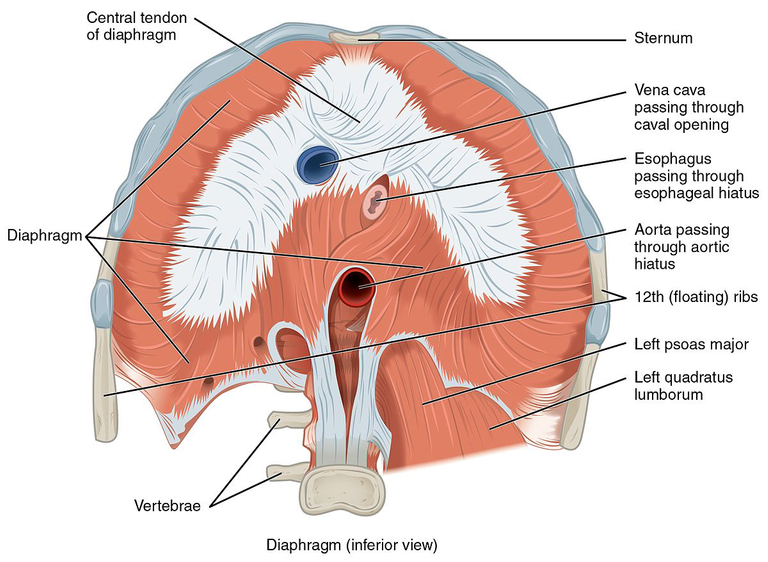The Diaphragm Is More Than Just a Muscle, it's Your Lifeline

Image from Rawpixel
Take a deep breath. Now exhale slowly. Did you feel that? That expansion of your chest, that inward movement of your abdomen? That's all thanks to one of the most important and yet often-overlooked muscles in the body - the diaphragm. Located just below the lungs and heart, the diaphragm is a large, dome-shaped muscle that separates the thoracic cavity (where your heart and lungs are located) from the abdominal cavity (where your digestive organs are located). Without this muscle, we wouldn't be able to breathe, speak, sing, or even laugh. In this article, we'll take a closer look at the anatomy of the diaphragm, its function, and its importance, as well as some of the disorders and injuries that can affect this crucial muscle. So let's dive in and learn more about the underrated diaphragm.
Position/location and the boundaries
The diaphragm is a flat, dome-shaped muscle that is positioned horizontally at the bottom of the thoracic cavity. It is located just below the lungs and heart and above the abdominal organs. The diaphragm separates the thoracic cavity from the abdominal cavity, and it divides the torso into two main cavities - the thoracic cavity and the abdominal cavity.
The boundaries of the diaphragm include the thoracic cage, which is made up of the ribs and sternum, and the lumbar spine. The diaphragm is bordered by the lower six ribs and their costal cartilages. It is also connected to the xiphoid process of the sternum at the front of the chest. Additionally, the diaphragm attaches to the lumbar vertebrae of the spine at its rear, which enables it to expand and contract during inhalation and exhalation.
The diaphragm plays a critical role in respiration by contracting and relaxing to create negative pressure that draws air into the lungs and expels it during exhalation. In addition to its role in breathing, the diaphragm also assists in other activities, such as swallowing, coughing, and even singing. Overall, the diaphragm is an essential muscle for proper body function and health.
The structure of the diaphragm and important openings

Source:Wikipedia
The diaphragm, like all other muscles, is made up of muscle fibers. These muscle fibers are Type I, or slow-twitch fibers, as they need to be able to contract and relax without getting tired, to allow sustained breathing. These muscle fibers contain many mitochondria which produce ATP, the energy source that enables the muscle fibers to contract repeatedly.
The diaphragm is attached to the lower ribs, sternum, and spine by a network of tough fibrous tissues called tendons and connective tissue. The tendons of the diaphragm help attach the muscle fibers to the central tendon of the diaphragm, which is a strong, flat sheet of connective tissue that separates the thoracic and abdominal cavities.
The connective tissue, including collagen and elastin fibers, provide strength and support to the diaphragm to facilitate its contraction and relaxation during breathing.
The diaphragm is composed of several components, including the arcuate ligaments, crura, and openings which allow for the passage of various structures such as the aorta, esophagus, and inferior vena cava.
The arcuate ligaments are two thick fibrous bands that are located in the posterior portion of the diaphragm, where the diaphragm attaches to the vertebral column. They take the form of arches and have been described as resembling extended arms. The two arcuate ligaments are the median arcuate ligament and the lateral arcuate ligament. The median arcuate ligament spans the anterior portion of the border of the diaphragm and passes over the aorta. The lateral arcuate ligament is located posterior to the last rib and passes over the psoas major muscle.
The crura of the diaphragm are two muscular bands that descend from the vertebral column to the level of the eleventh and twelfth ribs. The crura divide the diaphragm into a right and left half. The right and left crura of the diaphragm originate from the lumbar vertebrae and extend anteriorly to attach to the central tendon of the diaphragm.
The diaphragm has several openings through which various structures pass. These include the vena caval orifice, esophageal hiatus, and aortic hiatus. The vena caval orifice is an opening in the diaphragm through which the inferior vena cava passes. The esophageal hiatus is an opening located in the diaphragm through which the esophagus and vagus nerve pass. The aortic hiatus is the largest opening located in the diaphragm, through which the aorta and thoracic duct pass.
The arcuate ligaments and crura of the diaphragm are important structures that provide support and stability to the diaphragm. The various openings in the diaphragm allow for the passage of important structures in the body to facilitate their proper function.
Vessels and nerves of the diaphragm
The diaphragm is innervated by nerves and supplied by vessels that play a crucial role in its function and maintenance.
The primary nerve supply to the diaphragm is via the phrenic nerves, which arise from the spinal cord at the level of C3, C4, and C5. These nerves descend through the neck and into the chest where they innervate the diaphragm. The phrenic nerves provide motor innervation to the diaphragm muscle, which allows the diaphragm to contract and assist with respiration. The nerves also provide sensory innervation to the diaphragm, allowing for pain and other sensations to be perceived.
The arterial blood supply to the diaphragm is via branches of the internal thoracic and musculophrenic arteries. These arteries provide oxygenated blood to the diaphragm muscles, ensuring their proper function. The venous drainage of the diaphragm is primarily via the inferior phrenic veins, which drain into the inferior vena cava.
The lymphatic drainage of the diaphragm is via a network of lymphatic vessels that run throughout the muscle and drain into the thoracic duct and lymph nodes located near the diaphragm.
In addition to these structures, several important structures pass through or over the diaphragm. As mentioned earlier, the aorta, esophagus, and inferior vena cava all pass through the diaphragm in specific locations. The sympathetic trunk and splanchnic nerves also pass over the diaphragm and can impact its function.
In summary, the nerve, vascular, and lymphatic structures of the diaphragm are complex and play a critical role in its function. Understanding the anatomy and physiology of these structures is important for the proper diagnosis and treatment of conditions that affect the diaphragm.
The function of the diaphragm
The diaphragm is a large, dome-shaped muscle that separates the thoracic cavity from the abdominal cavity. It is a vital muscle involved in the process of respiration and serves several important functions in the body.
The primary function of the diaphragm is to breathe. During inhalation, the diaphragm contracts and moves inferiorly, causing a decrease in pressure in the thoracic cavity and an increase in volume. This creates a negative pressure gradient that draws air into the lungs through the nose or mouth. During exhalation, the diaphragm relaxes and moves superiorly, causing an increase in pressure in the thoracic cavity and a decrease in volume, which forces air out of the lungs.
The diaphragm also helps in the process of coughing, sneezing, and vomiting. It contracts forcefully to increase the pressure in the thoracic cavity, which can help expel air or particulate matter from the lungs or foreign materials from the upper airway or digestive tract.
Finally, the diaphragm plays a role in supporting the abdominal cavity. As the diaphragm contracts, it increases the pressure in the abdominal cavity, which helps support the abdominal organs and assists in activities such as defecation, urination, and childbirth.
Overall, the diaphragm is a critical muscle involved in breathing, coughing, sneezing, vomiting, and the support of the abdominal cavity. Any damage or dysfunction of this muscle can result in serious health consequences, underscoring the importance of understanding its anatomy and function.
Disorders and injuries of the diaphragm
While the diaphragm is a crucial muscle for breathing and supporting the abdominal cavity, it is not invulnerable to injury or dysfunction. However, it's important to remember that many diaphragmatic disorders can be treated successfully with early diagnosis and appropriate management.
One of the most common diaphragmatic disorders is diaphragmatic paralysis, where one or both sides of the diaphragm become weak or paralyzed. This may be due to injury, nerve damage, or disease, and can cause difficulty breathing, shortness of breath, and fatigue. However, with proper management such as diaphragmatic exercises and respiratory support, most people with diaphragmatic paralysis can experience significant improvement in their symptoms.
Another diaphragmatic disorder is a hernia, which occurs when a portion of the stomach or other abdominal organ pushes through the diaphragm into the chest cavity. This may cause chest pain, heartburn, and difficulty breathing, and often requires surgical intervention to correct.
Trauma, such as a penetrating injury to the chest or abdominal area, can also cause diaphragmatic injury. Symptoms may include difficulty breathing, shoulder pain, and chest pain. Treatment options include surgery to repair the damaged diaphragm.
Lastly, diseases such as emphysema and chronic obstructive pulmonary disease (COPD) can also impact the function of the diaphragm. By seeking proper medical care, many individuals with these conditions can achieve improved lung function and relief from symptoms.
While diaphragmatic disorders or injuries can be concerning, with early intervention and appropriate care, most individuals can improve their quality of life and reduce their symptoms. This can be achieved through physical therapy, medication, lifestyle changes, and in some cases, surgical intervention. So if you or someone you know is experiencing dysfunction or injury to the diaphragm, it's important to seek medical attention promptly.
The diaphragm may often be overlooked in our daily lives, but its functions are integral to our very existence, helping us breathe and even playing a role in our emotional well-being. As we've explored together, disorders and injuries of the diaphragm can have serious consequences on our health, which is why we must take care of this important muscle. From learning important breathing techniques to performing diaphragmatic exercises and seeking the appropriate medical attention, there are a plethora of options available to keep our diaphragm functioning optimally. By doing so, we can lead healthier, happier lives.
- "The Diaphragm: Anatomy, Function, and Treatment." University of Michigan Medicine. Retrieved from: https://www.uofmhealth.org/health-library/abd1828
- "Breathing and the Diaphragm." National Center for Biotechnology Information, US National Library of Medicine. Retrieved from: https://www.ncbi.nlm.nih.gov/pmc/articles/PMC5455070/
- "The Diaphragm: Definition, Function, Muscle & Innervation." Study.com. Retrieved from: https://study.com/academy/lesson/the-diaphragm-definition-function-muscle-innervation.html
- "The Incredible Diaphragm: How it Works and What Can Go Wrong." Cleveland Clinic. Retrieved from: https://health.clevelandclinic.org/the-incredible-diaphragm-how-it-works-and-what-can-go-wrong/
- "The Diaphragm: Your Body's Most Important Muscle." Yale New Haven Health. Retrieved from: https://www.ynhhs.org/patient-care/health-library/health-encyclopedia.aspx?chunkiid=35739
- "Diaphragmatic Breathing." The American Institute of Stress. Retrieved from: https://www.stress.org/diaphragmatic-breathing
- "The Role of the Diaphragm in Breathing, Core Stability, and Movement." Verywell Health. Retrieved from: https://www.verywellhealth.com/the-diaphragm-anatomy-and-function-2696194
- "The Diaphragm: The Forgotten Muscle of Respiration." Physiopedia. Retrieved from: https://www.physio-pedia.com/The_Diaphragm:_The_Forgotten_Muscle_of_Respiration



Thanks for your contribution to the STEMsocial community. Feel free to join us on discord to get to know the rest of us!
Please consider delegating to the @stemsocial account (85% of the curation rewards are returned).
You may also include @stemsocial as a beneficiary of the rewards of this post to get a stronger support.
Congratulations @jsalvage! You have completed the following achievement on the Hive blockchain And have been rewarded with New badge(s)
Your next target is to reach 65000 upvotes.
You can view your badges on your board and compare yourself to others in the Ranking
If you no longer want to receive notifications, reply to this comment with the word
STOPCheck out our last posts: